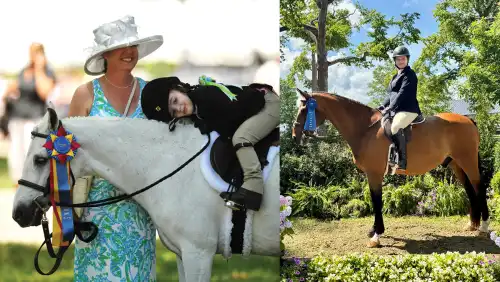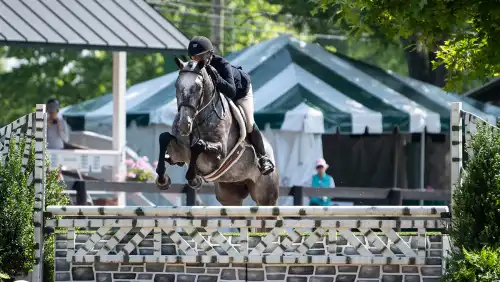The U.S. team prevailed for the gold medal in a jump-off against Canada, whose team fought back today, Aug. 18, despite having to withdraw Mac Cone’s horse, Ole, due to an injury. Norway jumped up to the bronze in an unprecedented achievement for their riders in Hong Kong, China.
“Not only was it an exclamation point for the U.S. but for North America, maybe the best day in our sport for North America,” said McLain Ward, lead-off rider for the U.S team.
The U.S. team entered today’s round on just 12 penalties from yesterday, tied with Switzerland, but the Swiss got off to a rough start when Christina Liebherr posted 23 faults on No Mercy, with three rails down, a foot in the water and a run-out at 12B. Although they could drop her score, their other riders failed to post a score better than 5 faults.
Meanwhile, Canada, even minus a drop score, was climbing the ranks after a perfect round from Jill Henselwood and just one rail at 12B for Eric Lamaze. When Ian Millar jumped a clear round, and Beezie Madden touched the tape at the water for the U.S., a jump-off was on. Cone had to withdraw Ole due to injury, possibly from the stutter step he took at the second fence yesterday.
The jump-off was decisive—Ward, Laura Kraut and Will Simpson posted three clears, so Madden didn’t have to return, since Henselwood had dropped a rail, and Canada had no drop score.
Steve Stephens, who designed the course with Leopoldo Palacios, was thrilled to have a jump-off and hopes to have another for the individual final. “It makes it more exciting for the sport,” he said. “The riders have to promote the sport, and we have to make it possible for them to be superstars.”
A Hard Battle
Kraut was ecstatic about posting an essential clear round today for the U.S. team aboard Cedric. “I have to give him a big kiss because he decided to peak at the right moment,” she said. “It’s shocking! I’m so excited. He’s such a great horse, and he knows it.”
She had a mishap in the warm-up arena, when Cedric thought a shadow was the ground line to a fence. He started to take off, then put back down and crashed through the fence, said Kraut. “It didn’t bother him at all; he’s so relaxed,” she said.
In the arena, she said he felt great. “The liverpool combination, he stood off a lot, and he soared over it. Once we were past that and the water, I thought I just had to stay cool and make it home.”
She’s optimistic about her horse’s energy level going into the individual final. “He’ll have two days off, and then we will have to start all over again getting him quiet. We put him on a longe tonight, and he just bucked and played.”
Ward started the U.S. effort with 4 faults on Sapphire, who just touched the tape at the water. “The horse didn’t make a mistake, I did,” he said. “I was slow to the water—I couldn’t decide if I wanted seven or eight [strides] until the last moment, and she lost momentum. The horses are getting tired, but they’ll have two days to rest.”
Like the previous night’s competition, the water played a pivotal role. The line started with a one-stride double (oxer to vertical) of liverpools at fence 6, followed by seven or eight strides on a bending line to the water, then six strides to a one-stride double of verticals. “The water is a real weapon for course designers,” said Ward. “It’s an easy way to get faults without being dangerous. We’ve got to pay a little more attention to the water in the next round.”
ADVERTISEMENT
But he was thrilled with Sapphire’s efforts; the mare has only just grazed one rail over three rounds now.
The water jump also came into play for Simpson and Carlsson Vom Dach, who had the final rail at fence 13 down as well. “I didn’t know he had it, and the horse didn’t know; he didn’t hit the water, just the tape,” said Simpson. “He’s a smart horse, and he made a great effort. I sat up a little too early [over the water] thinking about those verticals. You have to have a horse who jumps way up over the water; it’s hard to get the six in if they jump flat.”
After Millar posted a second clear round for Canada, Beezie Madden, as the final U.S. rider, had to jump clear to win the gold, but she, too, just touched the tape at the water with Authentic and set the stage for another round against Canada.
Canada Rallies
Henselwood got Canada off to a strong start with the first double-clear round of the day aboard Special Ed, coming back from 19 faults the day before. “You can imagine what I dreamt about, what I woke up talking about,” she said.
She changed Special Ed’s bit to a rubber snaffle with latex. “That’s not much bridle for the Olympics,” she said. “I dropped the amount of brakes to give him the feeling he was more in control, and we diminished his boots behind. He never faults behind, so to have the boots maybe intimidated him. We were just guessing to make it more favorable to his concentration.”
She said there was already so much pressure, the loss of Mac Cone hardly figured into her nerves. “Thank God I didn’t know that last night,” she said of his withdrawal. “We already have the flag on, so there’s so much pressure.”
Lamaze had nearly secured a clear round with Hickstead when he knocked the oxer at 12B. “It was so short [two strides] in the middle of the oxers, and I was thinking that the front rail was more of a risk and protected that [and had the back down],” he said.
When Millar entered the arena, he knew anything less than a perfect round would put the gold out of reach. “Anchor riders are a funny group; we’re not really normal people,” he said. “I know I’ve got to really control things because horses are going to feel everything you feel. It requires a tremendous amount of energy, but I know the job.
“The odds were not good [without a third rider], but you’ve got to try. Jill sure inspired us with her ride and set the standard for us to stay with, and that’s what we did,” he added.
History For Norway
Norway hasn’t even fielded a team since 1936, said anchor rider Tony Andre Hansen, whose 1-fault round clinched the team bronze for himself, Morten Djupvik, Geir Gulliksen and Stein Endresen.
“We were just hoping to make the final, and we just had to go and see the best we could do,” said Hansen, who rode Camiro to the top individual spot. “He’s not that quick, so I didn’t worry about the time. We were a bit lucky at the start, getting a bit deep, but finished very well and did what we were supposed to do.”
ADVERTISEMENT
“To get the bronze medal is not only a dream, it’s like winning gold,” said Gulliksen.
Whitaker Ruled Out
The Appeal Committee for equestrian events had to meet earlier today to determine whether John Whitaker of Great Britain would be able to start Round 2 in the team jumping competition.
The Ground Jury of Jean-Loup Caplain, David Distler, Chang-Kyoo Yang and Hanno Dohn had originally decided to allow Whitaker to compete, but seven of the possible eight teams filed a protest, since Whitaker had withdrawn Peppermill from the first round the night before.
The Committee upheld the objections under Article 264.4 Rules for Jumping Events and informed the chef de mission of the British team that Whitaker was not eligible to compete in the second round or the final. The Article reads, in part:
“4.1. A full Nations Cup team comprises four competitors each riding the same horse throughout the competition. All members of each team must take part in the first round, except as stated in paragraph 4.2 below and in paragraph 7.2.
4.2. If a team, comprising four competitors, cannot improve its placing in the first or second round after its third competitor has completed the course, the fourth competitor may be withdrawn.
The three-man team ended up seventh.
Germans Still Don’t Deliver
Germany finished well out of the medals in a tie for fifth after Christian Ahlmann and Meredith Michaels-Beerbaum each had rails, and Marco Kutscher had a stop at fence 8 while trying to slow down after the water, then dropped three more rails. Like Kutscher, Ludger Beerbaum also had a stop at fence 8A.
“He just didn’t want to go anymore,” said Kutscher of Cornet Obolensky. “I tried my best, and in the beginning he was very good, but after the water he gave up. In the end, I think he was a little too inexperienced for the Olympics.”
And for the U.S. jumpers, the victory put an old grudge to bed. The Germans won the gold in Athens four years ago but were stripped of their medal when Ludger Beerbaum’s horse tested positive for a prohibited substance. That elimination gave the gold to the U.S. team, which included Ward and Madden.
“We didn’t win by default; someone was caught not playing by the rules, and we’ve lived [with the idea that the medal wasn’t earned] for four years,” said Ward adamantly. “There was nothing that was default about that medal.”
Now the top 35 riders advance to the individual final, which will include reigning Olympic champion Rodrigo Pessoa and reigning World Champion Jos Lansink. That competition takes place on Thursday night, and riders will start on fresh scores. Only three riders from each country can advance to the final, so Ward, Kraut and Madden will return to try to add to their team gold.














